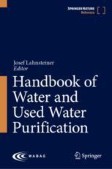Search
Search Results
-
Digital water: artificial intelligence and soft computing applications for drinking water quality assessment
Water quality deterioration in drinking water systems (i.e., system failure) causing serious outbreaks have frequently been happening around the...

-
Classification and Prediction of Developed Water Quality Indexes Using Soft Computing Tools
The water quality index (WQI) is a coherent method of expressing the state of the water quality, which has become complicated due to subjectivity and...

-
Water quality soft-sensor prediction in anaerobic process using deep neural network optimized by Tree-structured Parzen Estimator
Anaerobic process is regarded as a green and sustainable process due to low carbon emission and minimal energy consumption in wastewater treatment...

-
Rapid analysis of pharmaceutical and personal care products by soft microwave-based plasma ionization—linear ion trap mass spectrometer (SMPI-LTQ) in natural water
In this study, a soft microwave plasma torch (SMPT) combined with a mass spectrometer (MS) was used for the first time as an analytical method to...

-
Municipal Residential Water Consumption Estimation Techniques Using Traditional and Soft Computing Approach: a Review
Rate of urbanization in towns and cities is so rapid, which leads to increase in the demand of water. Any developmental activities depend on...

-
Development of AI-based hybrid soft computing models for prediction of critical river water quality indicators
Prediction of river water quality indicators (RWQIs) using artificial intelligence (AI)–based hybrid soft computing modeling techniques could provide...

-
Incorporation of information entropy theory, artificial neural network, and soft computing models in the development of integrated industrial water quality index
Kee** purpose and targeted end-users in perspective, several water quality indices have been developed over the past decades to summarily convey...

-
Prediction of Inland Aquaculture Ammonia Using Hybrid Intelligent Soft Computing
One of the crucial factors in assessing the pond's intensive inland aquaculture water quality condition is ammonia. The excessive ammonia content...
-
Hydrochemical characteristics and water quality assessment of natural water in the South China Mountains: the case in Lianzhou
South China Mountain Region has a well-developed water system with the most abundant water in China. Untreated natural water is the main source of...

-
Online soft measurement for wastewater treatment system based on hybrid deep learning
The existing automated wastewater treatment control systems encounter challenges such as the utilization of specialized testing instruments,...

-
Estimating of aqueduct water withdrawal via a wavelet-hybrid soft-computing approach under uniform and non-uniform climatic conditions
Due to climate change and the decrease of surface water resources recently, groundwater resources, especially aqueducts, have special importance to...

-
Jute Retting Using Free-flowing Water with Microbial Consortium Minimizes Water Requirement and Water Pollution
Jute retting is a process of bio-degradation of non-cellulosic materials primarily pectin and xylan by the enzymatic action of microbes present in...

-
Cooling Water Treatment
The function of a cooling system is to release the excess heat from industrial production processes or equipment for proper operation. This heat is...
-
Problems in applying Soft OR methods to climate actions: lessons from two cases of governmental use
The field of Soft Operational Research (Soft OR) has emerged from the attempt to address contextually rich, multi-actor ‘wicked’ problems that are...

-
Liquid phase oxidation enables stable soft carbon anodes for potassium-ion batteries
Soft carbon has been recognized as a promising anode material for potassium-ion batteries (PIBs), due to low cost, high conductivity and low voltage...

-
Sustainable application of waste construction slurry as a planting matrix capable of water and fertilizer retention
Waste construction slurry is a by-product of engineering construction, and the realization of eco-friendly disposal and resource utilization of waste...

-
La Niña Pushes an Endangered Temperate Soft Coral Species to the Brink of Localised Extinction
Extreme weather events such as floods are becoming more frequent, and pose a substantial threat to Australia’s nearshore marine communities. In March...

-
Water Pollution
This chapter introduces key aspects associated with water pollution. Drinking water and wastewater discharge guidelines are compared. A range of...
-
The seasonal evolution of subglacial drainage pathways beneath a soft-bedded glacier
Subglacial hydrology is a key element in glacier response to climate change, but investigations of this environment are logistically difficult. Most...

-
Experimental Investigation of Sand Seam Effects on Consolidation Behavior of Vertical Drain-Installed Soft Soils
Thin-layered sand seam in soft deposits can be formed artificially or naturally. It affects significantly the consolidation behavior of subsoil. To...
